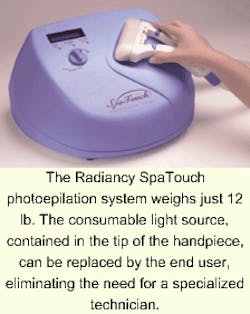Low-cost light-based system shakes up hair-removal market
Will light-based hair-removal systems one day be small enough, cheap enough, and safe enough for consumers to use in the privacy of their own homes? They very well could be if they utilize proprietary light-based technology being commercialized by Radiancy (Orangeburg, NY), a young company founded by former Sharplan CEO Eitan Nahum.
Radiancy recently unveiled its first aesthetic product, the SpaTouch photoepilation system, and is already competing head to head with the numerous hair-removal lasers on the US market (see Medical Laser Report, June 2000). The company is initially trying to get its foot in the door by selling the SpaTouch for just $15,000, well below the $50,000-$150,000 price tag of laser-based hair-removal products, which in turn should drastically reduce the cost to the consumer. Nahum maintains that the nonlaser, pulsed-light SpaTouch achieves long-lasting hair removal by incorporating a large spot size (22 x 55 mm) and some unique energy-utilization techniques that reduce the size and complexity of the system and eliminate the need for a cooling mechanism (see photo).
"There is a huge unmet need in the marketplace for this type of product, with health-care professionals and consumers seeking a simple and cost-effective solution," Nahum says. Existing laser and light-based technologies for hair removal have not enabled high-energy utilization, he adds, making current systems cumbersome and expensive. In addition, the high initial capital investment has kept the price of hair-removal services relatively high for the consumer, which has limited the technology's market penetration.
Underlying technology
"The key issue in our technology is the ability to achieve high-yield light energy," Nahum says. "Using lasers or even other pulsed light sources and trying to get the most output is very hard. To get a certain amount of energy, you have to build a big machine and power supply [plus the cooling mechanism, both for the skin and the system itself], so you get a large, expensive system that still has low energy utilization."
The underlying technology in the SpaTouch was developed by Zion Azar and Pini Shalev, researchers who now work for Radiancy in Israel overseeing the company's R&D and manufacturing operations. Similar to the photon-recycling technique developed by Rox Anderson at the Wellman Laboratory of Photomedicine (Cambridge, MA) and licensed to Palomar Medical Technologies (Lexington, MA) for hair removal, the SpaTouch incorporates a reflective mechanism that enables the heat created during the treatment process to be channeled into the follicle along with the light energy, thereby achieving the desired effect with much less energy from the system itself (see Medical Laser Report, Nov. 1999, p. 5).
According to Nahum, the SpaTouch uses six times less energy fluence than the laser hair-removal systems—4-7 J/cm2 (depending on the skin type) vs. an average of 25-40 J/cm2. In addition to lowering the overall system size and cost, this low-energy approach also eliminates the need for any active cooling mechanism, although a topical anesthetic cream can be used prior to treatment if the patient requests.
"We are using light to deliver energy down to the follicle, but we are also using the conduction of the heat," Nahum says. "Rather than fighting or trying to eliminate the heat, we are using it to help increase the amount of energy that is channeled into the follicle."
In clinical results submitted to the US Food and Drug Administration (FDA) prior to marketing clearance, Radiancy found that 90 days following one treatment of 39 people (126 tissue sites and various skin types and body parts), significant hair clearance was achieved. Another ongoing study has shown hair clearance for more than four months following three to five treatment sessions. Further, clinical studies are underway at three US sites, including the University of California, Los Angeles, and Boston Medical Center at Boston University, to determine how much longer the hair clearance will sustain.
Market strategy
The system is initially being marketed to aesthetic physicians, but Nahum believes that the hair-removal market also belongs to primary-care physicians, nurse practitioners, and other health-care professionals. Radiancy is also looking into other potential aesthetic applications where a low-cost, low-energy light-based system would be appropriate.
"The idea we have is to sell this product to those physicians who have wanted to join this market but could not afford to," Nahum says. "We are focusing on other applications and generations of this technology and are working to build an even smaller device that could possibly be used in the home market, once the efficacy and safety of the technology have been clinically proven."
About the Author
Kathy Kincade
Contributing Editor
Kathy Kincade is the founding editor of BioOptics World and a veteran reporter on optical technologies for biomedicine. She also served as the editor-in-chief of DrBicuspid.com, a web portal for dental professionals.
